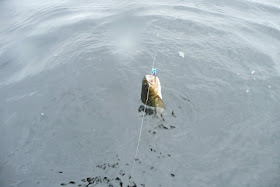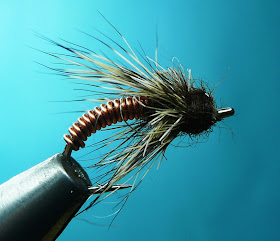Did Randall Kaufmann ever imagine his stonefly imitation would be revised by Irish lough fishers? I suspect not. Yet this is the case. His dry stimulator pattern has evoked a range of Irish wet fly variants, collectively labelled, 'Irish Stimulators', funny enough! The original orange body has been replaced with some quiensessiential Irish colours, fiery brown and sooty olive, for example. Moreover, to provide the wet-fly touch, the cock hackles have been replaced with cock saddles or even hen. These variants are used on loughs as part of a three fly wet fly cast. Yet, to my thinking, this seems a bob fly supremo. The deer hair wing and the thoraxed hackle provide more boyancy than maybe your average Irish wet fly.
As far I know, Mr Frankie McPhillips - the Fermanagh based professional fly tyer - introduced Irish colours to the original. So I thought I would do some research to construct a list of established patterns for your eyes. Green Irish Stimulator (Frankie McPhillips)
Hook: Diachi
Tail: Red squirrel or bucktail
Body: Green olive Frankie McPhillips Dubbing (no 6), or similar
Rib: Gold oval
Body hackle: Green olive cock saddle
Wing: Deer Hair
Thorax: orange seals fur
Note: Frank McPhillips states that there are no hard and fast rules with the tail. You could use floss, wool, bucktail or artic fox hair as alternatives.
Fiery Brown Irish Stimulator (Frankie McPhillips)
Hook: Diachi
Tail: Pheasant tail fibres
Body: Fiery Brown seals fur
Body hackle: Fiery brown cock saddle
Wing: Deer Hair
Thorax: Orange seals
Head hackle: Grizzle dyed orange
Black Irish Stimulator (Frankie McPhillips)
Hook:Kamasan B170 size 10
Tail: Black squirrel hair or deer hair
Body: Black seals fur
Rib: Oval silver
Body hackle: Black cock saddle
Wing: Black deer hair
Thorax: Orange
Head: Grizzle cock saddle
This is considered effective for Sea-Trout. Try a blue hackle through the thorax area for another variant.
Peter Stimulator
Hook: Kamasan B170 size 10
Butt: red seals fur
Body: green seals fur
Rib: oval gold
Body hackle: red game cock saddle
Wing: Deer Hair
Thorax: Red seals fur
Head hackle: red game cock
A minor variation of that brilliant great Irish sedge pattern - 'The Green Peter'.
Golden Stimulator
Hook: Kamasan B170
Tail: Golden pheasant tail dyed orange (or dyed squirrel)
Body: Golden olive seals fur
Rib: fine oval gold
Body hackle: golden olive cock
Wing: Golden Brown deer hair (or natural)
Thorax: Orange seals fur
Front hackle: Grizzle dyed golden brown (or orange dyed grizzle)
Hook: Diachi
Tail: Pheasant tail fibres
Body: Fiery Brown seals fur
Body hackle: Fiery brown cock saddle
Wing: Deer Hair
Thorax: Orange seals
Head hackle: Grizzle dyed orange
Black Irish Stimulator (Frankie McPhillips)
Hook:Kamasan B170 size 10
Tail: Black squirrel hair or deer hair
Body: Black seals fur
Rib: Oval silver
Body hackle: Black cock saddle
Wing: Black deer hair
Thorax: Orange
Head: Grizzle cock saddle
This is considered effective for Sea-Trout. Try a blue hackle through the thorax area for another variant.
Peter Stimulator
Hook: Kamasan B170 size 10
Butt: red seals fur
Body: green seals fur
Rib: oval gold
Body hackle: red game cock saddle
Wing: Deer Hair
Thorax: Red seals fur
Head hackle: red game cock
A minor variation of that brilliant great Irish sedge pattern - 'The Green Peter'.
Golden Stimulator
Hook: Kamasan B170
Tail: Golden pheasant tail dyed orange (or dyed squirrel)
Body: Golden olive seals fur
Rib: fine oval gold
Body hackle: golden olive cock
Wing: Golden Brown deer hair (or natural)
Thorax: Orange seals fur
Front hackle: Grizzle dyed golden brown (or orange dyed grizzle)




















































